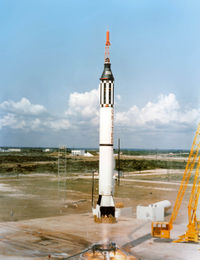
Table of Contents |
| History and missions of NASA |
The National Aeronautics and Space Administration (NASA) is an agency of the United States Government, responsible for that nation's public space program. Established on July 29, 1958 by the National Aeronautics and Space Act, its annual funding amounts to slightly more than $16 billion. In addition to the space program, it is also responsible for long-term civilian and military aerospace research. NASA is widely regarded as being in the forefront of space agencies worldwide.

Following the Soviet space program's launch of the world's first man-made satellite (Sputnik 1) on October 4, 1957, the attention of the United States turned toward its own fledgling space efforts. The U.S. Congress, alarmed by the perceived threat to U.S. security and technological leadership (known as "Sputnik Shock"), urged immediate and swift action; President Dwight D. Eisenhower and his advisors counseled more deliberate measures. Several months of debate produced agreement that a new federal agency was needed to conduct all nonmilitary activity in space.
On July 29, 1958, President Dwight D. Eisenhower signed the National Aeronautics and Space Act or NASA, establishing the National Aeronautics and Space Administration (NASA). When it began operations on October 1, 1958, NASA consisted mainly of the four laboratories and some 80 employees of the government's 46-year-old research agency for aeronautics, the National Advisory Committee for Aeronautics (NACA), though probably the most important contribution actually had its roots in the German rocket program led by Wernher von Braun, who is today regarded as the father of the United States space program. Elements of the Army Ballistic Missile Agency (of which von Braun's team was a part) and the Naval Research Laboratory were incorporated into NASA.
NASA's earliest programs were research into human spaceflight, and were conducted under the pressure of the competition between the USA and the USSR (the Space Race) that existed during the Cold War. The Mercury program, initiated in 1958, started NASA down the path of human space exploration with missions designed to discover simply if man could survive in space. Representatives from the U.S. Army (M.L. Raines, LTC, USA), Navy (P.L. Havenstein, CDR, USN) and Air Force (K.G. Lindell, COL, USAF) were selected/requested to provide assistance to the NASA Space Task Group through coordination with the existing U.S. military research and defense contracting infrastructure, and technical assistance resulting from experimental aircraft (and the associated military test pilot pool) development in the 1950s. On May 5, 1961, astronaut Alan B. Shepard Jr. became the first American in space when he piloted Freedom 7 on a 15-minute suborbital flight. John Glenn became the first American to orbit the Earth on February 20, 1962 during the 5-hour flight of Friendship 7.
Once the Mercury project proved that human spaceflight was possible, project Gemini was launched to conduct experiments and work out issues relating to a moon mission. The first Gemini flight with astronauts on board, Gemini III, was flown by Virgil "Gus" Grissom and John W. Young on March 23, 1965. Nine other missions followed, showing that long-duration human space flight was possible, proving that rendezvous and docking with another vehicle in space was possible, and gathering medical data on the effects of weightlessness on human beings.
The Apollo program was designed to land humans on the Moon and bring them safely back to Earth. Six of the missions (Apollos 11, 12, 14, 15, 16, and 17) did achieve this goal. Apollo 7 and Apollo 9 were Earth orbiting missions and were designed to test the operating systems of the Command and Lunar Modules including rendezvous radar and essential life support systems. Apollo 8 and Apollo 10 tested various components while orbiting the Moon, and returned photography of the lunar surface. Apollo 13 did not land on the Moon due to a malfunction, but also returned photographs. The six missions that landed on the Moon returned a wealth of scientific data and almost 400 kilograms of lunar samples. Experiments included soil mechanics, meteoroids, seismic, heat flow, lunar ranging, magnetic fields, and solar wind experiments.
Although the vast majority of NASA's budget has been spent on human spaceflight, there have been many robotic missions instigated by the space agency. In 1962 the Mariner 2 mission was launched and became the first spacecraft to make a flyby of another planet, in this case Venus. The Ranger, Surveyor, and Lunar Orbiter missions were essential to assessing lunar conditions before attempting Apollo landings with humans on board. Later, the two Viking probes landed on the surface of Mars and sent color images back to Earth, but perhaps more impressive were the Pioneer and particularly Voyager missions that visited Jupiter, Saturn, Uranus and Neptune sending back scientific information and color images.
Having lost the moon race, the Soviet Union had, along with the USA, changed its approach. On July 17, 1975 Apollo 18 (finding a new use after the cancelling of planned lunar flights) was docked to the Soviet Soyuz 19 spacecraft, in the Apollo-Soyuz Test Project. Although the Cold War would last many more years, this was a critical point in NASA's history and much of the international co-operation in space exploration that exists today has its genesis with this mission. America's first space station, Skylab, occupied NASA from the end of Apollo until the late 1970s.
.jpg)
The space shuttle became the major focus of NASA in the late 1970s and the 1980s. Planned to be a frequently launchable and mostly reusable vehicle, four space shuttles were built by 1985. The first to launch, Columbia, did so on April 12, 1981.
The shuttle was not all good news for NASA; flights were much more expensive than initially projected, and even after the 1986 Challenger disaster highlighted the risks of space flight, the public again lost interest as missions appeared to become mundane. Work began on Space Station Freedom as a focus for the manned space program but within NASA there was argument that these projects came at the expense of more inspiring unmanned missions such as the Voyager probes. The Challenger disaster, aside from the late 1980s, marked a low point for NASA.
Nonetheless, the shuttle has been used to launch milestone projects like the Hubble Space Telescope (HST). The HST was created with a relatively small budget of $2 billion but has continued operation since 1990 and has delighted both scientists and the public. Some of the images it has returned have become near-legendary, such as the groundbreaking Hubble Deep Field images. The HST is a joint project between the European Space Agency (ESA) and NASA, and its success has paved the way for greater collaboration between the agencies.
In 1995 Russian-American interaction would again be achieved as the Shuttle-Mir missions began, and once more a Russian craft (this time a full-fledged space station) docked with an American vehicle. This cooperation continues to the present day, with Russia and America the two biggest partners in the largest space station ever built the International Space Station (ISS). The strength of their cooperation on this project was even more evident when NASA began relying on Russian launch vehicles to service the ISS following the 2003 Columbia disaster, which grounded the shuttle fleet for well over two years.
Costing over one hundred billion dollars, it has been difficult at times for NASA to justify the ISS. The population at large have historically been hard to impress with details of scientific experiments in space, preferring news of grand projects to exotic locations. Even now, the ISS cannot accommodate as many scientists as planned.
During much of the 1990s, NASA was faced with shrinking annual budgets due to Congressional belt-tightening in Washington, DC. In response, NASA's ninth administrator, Daniel S. Goldin, pioneered the "faster, better, cheaper" approach that enabled NASA to cut costs while still delivering a wide variety of aerospace programs (Discovery Program). That method was criticized and re-evaluated following the twin losses of Mars Climate Orbiter and Mars Polar Lander in 1999.
NASA's shuttle program has made 114 successful launches yet.
Utilizing the 30 years of robotic, interplanetary exploration experience from the Jet Propulsion Lab (JPL), NASA's current investigations include in-depth surveys of Mars. The Mars Global Surveyor probe has been performing science in Mars orbit from 1997 to date. Since 2001, the orbiting Mars Odyssey has been searching for evidence of past or present water and volcanic activity on the red planet. The Mars Reconnaissance Orbiter, which reached Mars in 2006, will continue investigations of Martian climate and geology. Both built and managed by JPL, the most spectacular missions, however, have been the Mars Exploration Rovers Spirit and Opportunity, which have been traversing the surface of Mars at Gusev Crater and Meridiani Planum since early 2004, returning thousands of images and other scientific data. With NASA funding, JPL expects to continue to explore the Red Planet with more spacecraft such as Phoenix and the Mars Science Laboratory later this decade.
Scheduled to launch in 2007, Phoenix shall search for possible underground water courses in the northern Martian pole. The name "Phoenix" is appropriately given. During the dark days (accidents) of Mars Climate Orbiter and Mars Polar Lander, the prime contractor to JPL -- Lockheed Martin, Denver -- mothballed an identical Mars Polar Lander. With the success of the Mars Exploration Rovers, JPL and Lockheed Martin have "revived" the Mars mission to search for underground water in the northern poles. Hence, the name "Phoenix" was given to the "un-mothballed" identical, Mars Polar Lander probe.
Other notable JPL-NASA missions include the Cassini probe, launched in 1997 and in orbit around Saturn since mid-2004, investigating Saturn and its inner satellites; and the New Horizons mission, launched 2006 and due to reach Pluto in 2015. With over twenty years in the making, Cassini-Huygens demonstrates the importance of international cooperation between JPL-NASA and the European Space Agency (ESA).
The Space Shuttle Columbia disaster in 2003, which killed the crew of six Americans and one Israeli, caused a 29-month hiatus in space shuttle flights and triggered a serious re-examination of NASA's priorities. The U.S. government, various scientists, and the public all considered the future of the space program.
On January 14, 2004, ten days after the landing of Spirit, President George W. Bush announced a new plan for NASA's future, dubbed the Vision for Space Exploration. According to this plan, humankind will return to the moon by 2018, and set up outposts as a testbed and potential resource for future missions. The space shuttle will be retired in 2010 and Orion will replace it by 2014, capable of both docking with the ISS and leaving the Earth's orbit. The future of the ISS is somewhat uncertain construction will be completed, but beyond that is less clear. Although the plan initially met with skepticism from Congress, in late 2004 Congress agreed to provide start-up funds for the first year's worth of the new space vision.
Hoping to spur innovation from the private sector, NASA established a series of Centennial Challenges, technology prizes for non-government teams, in 2004. The Challenges include tasks that will be useful for implementing the Vision for Space Exploration, such as building more efficient astronaut gloves.
Jet Propulsion Laboratory, Pasadena, California
Langley Research Center, Hampton, Virginia
John H. Glenn Research Center at Lewis Field, Cleveland, Ohio
Goddard Institute for Space Studies, New York
Ames Research Center, Moffett Field, California
Dryden Flight Research Center, Edwards, California
Goddard Space Flight Center, Greenbelt, Maryland
Independent Verification and Validation Facility, Fairmont, West Virginia
Langley Research Center, Hampton, Virginia
John C. Stennis Space Center, near Bay St. Louis, Mississippi
Wallops Flight Facility, Wallops Island, Virginia
| Aerospace knowledge |
Aeronautics is the science of flight. Aeronautics is the method of designing an airplane or other flying machine. There are four basic areas that aeronautical engineers must understand in order to be able to design planes. To design a plane, engineers must understand all of these elements.
1. Aerodynamics is the study of how air flows around the airplane. By studying the way air flows around the plane the engineers can define the shape of the plane. The wings, the tail and the main body (fuselage) of the plane all affect the way the air will move around the plane.
2. Propulsion is the study of how to design an engine that will provide the thrust that is needed for a plane to take off and fly through the air. The engine provides the power for the airplane. The study of propulsion is how the engineers determine the right kinds of engine and the right amount of power that a plane will need
3. Materials and Structures is the study of what materials are to be used on the plane and in the engine and how those materials make the plane strong enough to fly effectively. The choice of materials that are used to make the fuselage wings, tail and engine will affect the strength and stability of the plane. Most airplane materials are now made out of composites, materials that are stronger and more lightweight than most metals.
4. Stability and Control is the study of how to control the speed, direction, altitude and other conditions that affect how a plane flies. The engineers' design the controls that are needed in order to fly and instruments are provided for the pilot in the cockpit of the plane. The pilot uses these instruments to control the stability of the plane during flight.
All jet engines, which are often called, gas turbines, work on the principle that a tremendous thrust is required to drive the plane forward. The engine sucks air in at the front. The inlet and fan pull the air in. The compressor, raises the pressure of the air. The compressed air is then sprayed with fuel and the mixture is lit by an electric spark. The burning gases expand and blast out through the back of the engine. As the jets of gas shoot backward, the nozzle releases the air and gas mixture and the engine and the aircraft are thrust forward. Jet engines drive aircraft forward with great force.
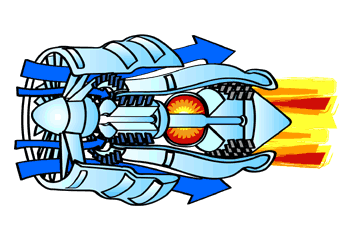

Fan - The fan is the first component in a turbofan. The fan pulls air into the engine. The large spinning fan sucks in large quantities of air. It then, speeds the air up and splits it into two parts. One part continues through the "core" or center of the engine, where it is acted upon by the other engine components. The second part "bypasses" the core of the engine, instead traveling through a duct that surrounds the core to the back of the engine where it produces much of the force that propels the airplane forward.
Compressor - The compressor is the first component in the engine core. The compressor squeezes the air that enters it into smaller areas, resulting in an increase in the air pressure. This results in an increase in the energy potential of the air. The squashed air is forced into the combustion chamber.
Combustor - In the combustor the air is mixed with fuel and then ignited. This process results in high temperature, high energy airflow. The fuel burns with the oxygen in the compressed air, producing hot expanding gases.
Turbine - The high energy airflow coming out of the combustor goes into the turbine, causing the turbine blades to rotate. This rotation extracts some energy from the high-energy flow that is used to drive the fan and the compressor. The gases produced in the combustion chamber move through the turbine and spin its blades. The task of a turbine is to convert gas energy into mechanical work to drive the compressor.
Nozzle - The nozzle is the exhaust duct of the engine. The energy depleted airflow that passed the turbine, in addition to the colder air that bypassed the engine core, produces a force when exiting the nozzle that acts to propel the engine, and therefore the airplane, forward. The combination of the hot air and the cold air are expelled and produce an exhaust which causes a forward thrust. The nozzle may be preceded by a mixer, which combines the high temperature air coming from the engine core with the lower temperature air that was bypassed in the fan. This results in a quieter engine than if the mixer was not present.
Afterburner - In addition to the basic components of a gas turbine engine, one other process is occasionally employed to increase the thrust of a given engine. Afterburning (or reheat) is a method of augmenting the basic thrust of an engine to improve the aircraft takeoff, climb and (for military aircraft) combat performance. Afterburning consists of the introduction and burning of raw fuel between the engine turbine and the jet pipe propelling nozzle, utilizing the unburned oxygen in the exhaust gas to support combustion. The increase in the temperature of the exhaust gas increases the velocity of the jet leaving the propelling nozzle and therefore increases the engine thrust. This increased thrust could be obtained by the use of a larger engine, but this would increase the weigh and overall fuel consumption.
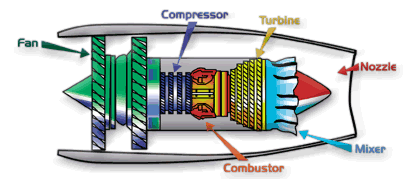
Turbine Engine Drawing

Fan - The fan is the first component in a turbofan. The fan pulls air into the engine. The large spinning fan sucks in large quantities of air. It then, speeds the air up and splits it into two parts. One part continues through the "core" or center of the engine, where it is acted upon by the other engine components. The second part "bypasses" the core of the engine, instead traveling through a duct that surrounds the core to the back of the engine where it produces much of the force that propels the airplane forward.
Compressor - The compressor is the first component in the engine core. The compressor squeezes the air that enters it into smaller areas, resulting in an increase in the air pressure. This results in an increase in the energy potential of the air. The squashed air is forced into the combustion chamber.
Combustor - In the combustor the air is mixed with fuel and then ignited. This process results in high temperature, high energy airflow. The fuel burns with the oxygen in the compressed air, producing hot expanding gases.
Turbine - The high energy airflow coming out of the combustor goes into the turbine, causing the turbine blades to rotate. This rotation extracts some energy from the high-energy flow that is used to drive the fan and the compressor. The gases produced in the combustion chamber move through the turbine and spin its blades. The task of a turbine is to convert gas energy into mechanical work to drive the compressor.
Nozzle - The nozzle is the exhaust duct of the engine. The energy depleted airflow that passed the turbine, in addition to the colder air that bypassed the engine core, produces a force when exiting the nozzle that acts to propel the engine, and therefore the airplane, forward. The combination of the hot air and the cold air are expelled and produce an exhaust which causes a forward thrust. The nozzle may be preceded by a mixer, which combines the high temperature air coming from the engine core with the lower temperature air that was bypassed in the fan. This results in a quieter engine than if the mixer was not present.
Afterburner - In addition to the basic components of a gas turbine engine, one other process is occasionally employed to increase the thrust of a given engine. Afterburning (or reheat) is a method of augmenting the basic thrust of an engine to improve the aircraft takeoff, climb and (for military aircraft) combat performance. Afterburning consists of the introduction and burning of raw fuel between the engine turbine and the jet pipe propelling nozzle, utilizing the unburned oxygen in the exhaust gas to support combustion. The increase in the temperature of the exhaust gas increases the velocity of the jet leaving the propelling nozzle and therefore increases the engine thrust. This increased thrust could be obtained by the use of a larger engine, but this would increase the weigh and overall fuel consumption.

Turbine Engine Drawing
The basic idea of the turbojet engine is simple. Air taken in from an opening in the front of the engine is compressed to 3 to 12 times its original pressure in a centrifugal or axial compressor. Fuel is added to the air and burned in a combustion chamber to raise the temperature of the fluid mixture to about 1,100°F to 1,300° F. The resulting hot air is passed through a turbine, which drives the compressor. If the turbine and compressor are efficient, the pressure at the turbine discharge will be nearly twice the atmospheric pressure, and this excess pressure is sent to the nozzle to produce a high-velocity stream of gas which produces a thrust. Substantial increases in thrust can be obtained by employing an afterburner. It is a second combustion chamber positioned after the turbine and before the nozzle.The afterburner increases the temperature of the gas ahead of the nozzle. The result of this increase in temperature is an increase of about 40 percent in thrust at takeoff and a much larger percentage at high speeds once the plane is in the air.
The turbojet engine is called a reaction engine. In a reaction engine, expanding gases push hard against the front of the engine. The turbojet sucks in air and compresses or squeezes it. The gases flow through the turbine and make it spin. These gases bounce back and shoot our of the rear of the exhaust, pushing the plane forward.
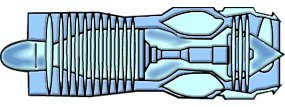
A turboprop engine is a jet engine attached to a propellor. The turbine at the back is turned by the hot gases, and this turns a shaft that drives the propellor. Some small airliners and transport aircraft are powered by turboprops.
Like the turbojet, the turboprop engine consists of a compressor, combustion chamber, and turbine, the air and gas pressure is used to run the turbine, which then creates power to drive the compressor. Compared with a turbojet engine, the turboprop has better propulsion efficiency at flight speeds below about 500 miles per hour. Modern turboprop engines are equipped with propellers that have a smaller diameter but a larger number of blades for efficient operation at much higher flight speeds. To accommodate the higher rotative and flight speeds, the blades are scimitar-shaped with swept-back leading edges at the blade tips. Engines featuring such propellers are called propfans.
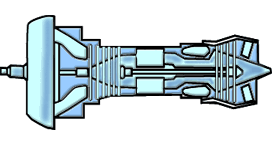
Picture of turboprop engine
A turbofan engine has a large fan at the front, which sucks in air. Most of the air flows around the outside of the engine, making it quieter and giving more thrust at low speeds. Most of today's airliners are powered by turbofans. In a turbojet all the air entering the intake passes through the gas generator, which is composed of the compressor, combustion chamber, and turbine. In a turbofan engine only a portion of the incoming air goes into the combustion chamber. The remainder passes through a fan, or low-pressure compressor, and is ejected directly as a "cold" jet or mixed with the gas-generator exhaust to produce a "hot" jet. The objective of this sort of bypass system is to increase thrust without increasing fuel consumption. It achieves this by increasing the total air-mass flow and reducing the velocity within the same total energy supply.
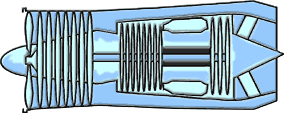
Picture of Turbofan Engine
This is another form of gas-turbine engine that operates much like a turboprop system. It does not drive a propellor. Instead, it provides power for a helicopter rotor. The turboshaft engine is designed so that the speed of the helicopter rotor is independent of the rotating speed of the gas generator. This permits the rotor speed to be kept constant even when the speed of the generator is varied to modulate the amount of power produced.

Picture of Turboshaft Engine
The most simple jet engine has no moving parts. The speed of the jet "rams" or forces air into the engine. It is essentially a turbojet in which rotating machinery has been omitted. Its application is restricted by the fact that its compression ratio depends wholly on forward speed. The ramjet develops no static thrust and very little thrust in general below the speed of sound. As a consequence, a ramjet vehicle requires some form of assisted takeoff, such as another aircraft. It has been used primarily in guided-missile systems. Space vehicles use this type of jet.
The body of the plane is called the fuselage. It is generally a long tube shape. The wheels of a plane are called the landing gear. There are two main wheels on either side of the plane fuselage. Then there is one more wheel near the front of the plane. The brakes for the wheels are like the brakes for cars. They are operated by pedals, one for each wheel. Most landing gear can be folded into the fuselage during the flight and opened for landing.
All planes have wings. The wings are shaped with smooth surfaces. There is a curve to the wings which helps push the air over the top more quickly than it goes under the wing. As the wing moves, the air flowing over the top has farther to go and it moves faster than the air underneath the wing. So the air pressure above the wing is less than below it. This produces the upward lift. The shape of the wings determines how fast and high the plane can fly. Wings are called airfoils.
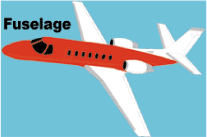 |
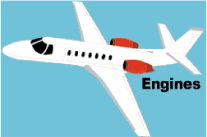 |
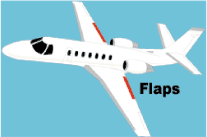 |
 |
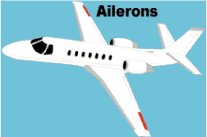 |
 |
The hinged control surfaces are used to steer and control the airplane. The flaps and ailerons are connected to the backside of the wings. The flaps slide back and down to increase the surface of the wing area. They also tilt down to increase the curve of the wing. The slats move out from the front of the wings to make the wing space larger. This helps to increase the lifting force of the wing at slower speeds like takeoff and landing. The ailerons are hinged on the wings and move downward to push the air down and make the wing tilt up. This moves the plane to the side and helps it turn during flight. After landing, the spoilers are used like air brakes to reduce any remaining lift and slow down the airplane.
The tail at the rear of the plane provides stability. The fin is the vertical part of the tail. The rudder at the back of the plane moves left and right to control the left or right movement of the plane. The elevators are found at the rear of the plane. They can be raised or lowered to change the direction of the plane's nose. The plane will go up or down depending on the direction of that the elevators are moved.
Air is a physical substance which has weight. It has molecules which are constantly moving. Air pressure is created by the molecules moving around. Moving air has a force that will lift kites and balloons up and down. Air is a mixture of different gases; oxygen, carbon dioxide and nitrogen. All things that fly need air. Air has power to push and pull on the birds, balloons, kites and planes.
In 1640, Evagelista Torricelli discovered that air has weight. When experimenting with measuring mercury, he discovered that air put pressure on the mercury.
Francesco Lana used this discovery to begin to plan for an airship in the late 1600s. He drew an airship on paper that used the idea that air has weight. The ship was a hollow sphere which would have the air taken out of it. Once the air was removed, the sphere would have less weight and would be able to float up into the air. Each of four spheres would be attached to a boat-like structure and then the whole machine would float. The actual design was never tried.
Hot air expands and spreads out and it becomes lighter than cool air. When a balloon is full of hot air it rises up because the hot air expands inside the balloon. When the hot air cools and is let out of the balloon the balloon comes back down.
Airplane wings are curved on the top which make air move faster over the top of the wing. The air moves faster over the top of a wing. It moves slower underneath the wing. The slow air pushes up from below while the faster air pushes down from the top. This forces the wing to lift up into the air.
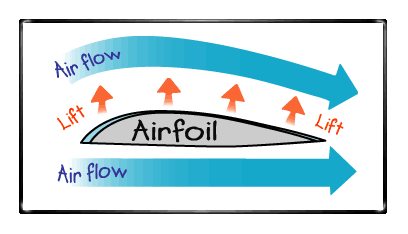
Four forces of flight Lift - upward Drag - down and backward Weight - downward Thrust - forward |
|
How does a plane fly? Let's pretend that our arms are wings. If we place one wing down and one wing up we can use the roll to change the direction of the plane. We are helping to turn the plane by yawing toward one side. If we raise our nose, like a pilot can raise the nose of the plane, we are raising the pitch of the plane. All these dimensions together combine to control the flight of the plane. A pilot of a plane has special controls that can be used to fly the plane. There are levers and buttons that the pilot can push to change the yaw, pitch and roll of the plane.
To roll the plane to the right or left, the ailerons are raised on one wing and lowered on the other. The wing with the lowered aileron rises while the wing with the raised aileron drops.
Pitch is to make a plane descend or climb. The pilot adjusts the elevators on the tail to make a plane descend or climb. Lowering the elevators caused the airplane's nose to drop, sending the plane into a down. Raising the elevators causes the airplane to climb.
Yaw is the turning of a plane. When the rudder is turned to one side, the airplane moves left or right. The airplane's nose is pointed in the same direction as the direction of the rudder. The rudder and the ailerons are used together to make a turn
|
 |
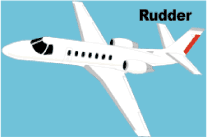 |
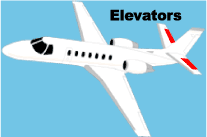 |
To control a plane a pilot uses several instruments...
The pilot controls the engine power using the throttle. Pushing the throttle increases power, and pulling it decreases power.
The ailerons raise and lower the wings. The pilot controls the roll of the plane by raising one aileron or the other with a control wheel. Turning the control wheel clockwise raises the right aileron and lowers the left aileron, which rolls the aircraft to the right.
l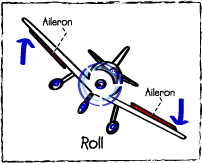
Picture of plane in roll
The rudder works to control the yaw of the plane. The pilot moves rudder left and right, with left and right pedals. Pressing the right rudder pedal moves the rudder to the right. This yaws the aircraft to the right. Used together, the rudder and the ailerons are used to turn the plane.
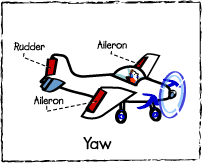
Picture of plane Yaw
The elevators which are on the tail section are used to control the pitch of the plane. A pilot uses a control wheel to raise and lower the elevators, by moving it forward to back ward. Lowering the elevators makes the plane nose go down and allows the plane to go down. By raising the elevators the pilot can make the plane go up.
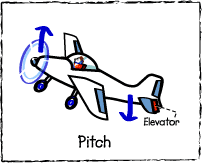
Picture of Plane Pitch
The pilot of the plane pushes the top of the rudder pedals to use the brakes. The brakes are used when the plane is on the ground to slow down the plane and get ready for stopping it. The top of the left rudder controls the left brake and the top of the right pedal controls the right brake.
If you look at these motions together you can see that each type of motion helps control the direction and level of the plane when it is flying.

Sometimes called speeds of flight, each regime is a different level of flight speed.
Seaplane |
General Aviation(100-350 MPH). Most of the early planes were only able to fly at this speed level. Early engines were not as powerful as they are today. However, this regime is still used today by smaller planes. Examples of this regime are the small crop dusters used by farmers for their fields, two and four seater passenger planes, and seaplanes that can land on water. |
Boeing 747 |
Subsonic (350-750 MPH). This category contains most of the commercial jets that are used today to move passengers and cargo. The speed is just below the speed of sound. Engines today are lighter and more powerful and can travel quickly with large loads of people or goods. |
Concorde |
Supersonic (760-3500 MPH - Mach 1 - Mach 5). 760 MPH is the speed of sound. It is also called MACH 1. These planes can fly up to 5 times the speed of sound. Planes in this regime have specially designed high performance engines. They are also designed with lightweight materials to provide less drag. The Concorde is an example of this regime of flight. |
Space Shuttle |
Hypersonic (3500-7000 MPH - Mach 5 to Mach 10). Rockets travel at speeds 5 to 10 times the speed of sound as they go into orbit. An example of a hypersonic vehicle is the X-15, which is rocket powered. The space shuttle is also an example of this regime. New materials and very powerful engines were developed to handle this rate of speed. |
When you experience a push or a pull, we say that a force is acting upon you. Gravity is a special force said to result when two masses attract each other, but what is mass? No one has ever answered that question clearly. All scientists say is "mass is the amount of stuff in an object (which, actually, isn't very helpful). An object that has a large mass is harder to push, and engineers have designed scales to measure mass. Bathroom scales have a spring in them, and the more mass you put on the scale, the more the spring compresses and the higher the reading (the number shown on the scale). So we can measure mass even if we don't quite know how to define it.
You know that bathroom scales measure your weight, so how can they measure mass also? Your weight is the force of the Earth's mass pulling on your mass. This force increases as your mass increases. For example, if your mass doubles, then your weight on Earth doubles. Then why have two different things - mass and weight? Although your mass won't change if you go to the Moon, your weight will be less because the Moon has less mass and won't attract you as strongly as the Earth does. We need both ideas to fully understand and define how objects behave in gravity. Are you confused? Don't worry; it took scholars centuries to get these concepts straight.
Galileo (1564-1642) made careful observations of falling bodies. He demonstrated that all bodies fall at roughly the same rate. Kepler (1571-1630) proposed three laws governing how planets move around the Sun. Neither Galileo nor Kepler developed a correct theory of gravity. However, their contributions were extremely valuable to the progress of science.
Newton (1642-1727) built on the ideas and observations of Galileo, Kepler, and other scholars to explain gravity. His idea was that gravity was a force that resulted from masses attracting each other. Newton was able to explain the motion of the planets around the Sun with this idea.
Einstein (1879-1955) refined Newton's concept of gravity to say that mass affects space. In his theory, the planets follow a path in the "warped" space around the Sun's mass.
That was a very brief history of gravity. If you find gravity interesting, you should keep reading about it. It takes math skills to understand gravity. You can improve your understanding of gravity as you grow and develop your mind.
The main gravity force at the International Space Station (ISS) comes from the Earth because it is the closest large body. The farther away a mass is, the smaller its gravity force, so the Moon and Sun don't have as much effect because they are a lot farther away from the ISS. (The mass of an object also plays a role, but that is another lesson!) An object is in free fall when the major force acting upon it is from gravity. For example, when astronaut David Scott dropped a hammer on the Moon, where there is almost no air resistance, the hammer was in free fall.
The ISS free-falls as it orbits the Earth. If there were no forces acting on the ISS, it would travel in a straight line away from the Earth. Because the Earth pulls the ISS towards it and is traveling 7900 meters per second (26,000 feet per second) parallel to the Earth's surface, the ISS moves around the Earth in a circle. Do you know that you could start a ball orbiting the Earth if you (1) threw it horizontally at 7900 meters per second, (2) it didn't hit anything (like a mountain), and (3) the ball was above the atmosphere? The best baseball pitchers can throw a baseball about 50 meters per second, so it would take a rocket to launch your ball into orbit.
The force of gravity on both the astronauts in the ISS and the ISS itself is about nine-tenths of what it is at the Earth's surface. Why do you think NASA astronauts in the ISS feel weightless? You only feel weight when something pushes against you. The ISS can't push the astronauts because both the ISS and the NASA astronauts free-fall at the same rate. (They are traveling at the same speed and in the same direction.) Astronauts in the ISS appear to be floating, but it is more correct to say they are in "free fall."
 Limited visibility is the single greatest contributing factor in most fatal worldwide airline and general aviation crashes. In commercial aviation, over 30% of all fatal accidents are categorized as controlled flight into terrain accidents (CFIT). A CFIT accident usually occurs at night or in bad weather when a normally functioning aircraft flies into a mountainside or other obstacle because the pilot doesn't realize the plane is headed in the wrong direction. Another major accident category affecting flights in the U.S. is called a runway incursion, in which an aircraft on the ground comes into contact with another plane or object on the runway. Many of these accidents may be prevented thanks to a revolutionary new cockpit display system currently being developed by NASA. Working with the aeronautics industry, NASA is developing a virtual reality display system called Synthetic Vision.
Limited visibility is the single greatest contributing factor in most fatal worldwide airline and general aviation crashes. In commercial aviation, over 30% of all fatal accidents are categorized as controlled flight into terrain accidents (CFIT). A CFIT accident usually occurs at night or in bad weather when a normally functioning aircraft flies into a mountainside or other obstacle because the pilot doesn't realize the plane is headed in the wrong direction. Another major accident category affecting flights in the U.S. is called a runway incursion, in which an aircraft on the ground comes into contact with another plane or object on the runway. Many of these accidents may be prevented thanks to a revolutionary new cockpit display system currently being developed by NASA. Working with the aeronautics industry, NASA is developing a virtual reality display system called Synthetic Vision.
Synthetic Vision combines the Global Positioning Systems (GPS), terrain databases, and graphical displays to create a three-dimensional scene of what the pilot should be seeing outside the plane. The only difference between this "synthetic" view and the "real world" is that every day is "picture perfect." It's clear skies always, even in the worst weather conditions, for pilots using synthetic vision.
The GPS identifies the aircraft's position. Based upon this information, the synthetic vision software searches through terrain databases to pull together a map of this location. As the aircraft's position changes, the map changes, too. The pilot sees an accurate, 3D-moving display in the cockpit.
Dozens of pilots have already tested this technology. During the flight evaluations, the test pilots' windshields were often intentionally covered or flights were conducted at night. Low visibility conditions were simulated so pilots would be forced to rely on the computer-generated information on the displays. So far, these pilots have been thrilled by the results. "I think it's awesome," said Rick Shay, a United Airlines 767 captain. "To explain the difference in the situational awareness that you gain, it's just a complete leap from the technology that's there."
The information the pilot sees may be displayed in different ways. One, a head-down display (HDD), is mounted in the plane's instrument panel. The HDD is not transparent but is bigger and more detailed. The images displayed on the HDD are photo quality, down to the trees on the mountains.
A second display, the heads-up display (HUD), superimposes the images onto a screen that is located in front of the pilots' eyes. This screen is transparent and is similar to the displays fighter pilots use. The HUD is monochromatic -- everything in shades of green -- and displays only outlines and shading.
This amazing technology has the potential to drastically improve safety for pilots. Imagine a world where it is always clear and sunny.